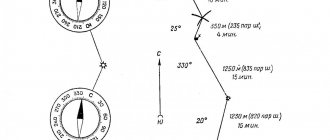When arranging a country house, we pay special attention to vegetation, because a garden and vegetable garden are the pride of every owner.
Let's figure out how to properly plant trees on a plot according to Feng Shui, what bushes, flowers and fruit trees you can “plant” in your home, and where it is best to place them. Plants are always needed because they carry living energy that has a positive effect on the surrounding space and people spending time in the country.
Apple tree
Symbolizes fertility, as well as the feminine principle. It gives women special sensuality and sexuality, awakens the maternal instinct. Girls come to the apple tree to talk about health, love, and ask for happiness. But it’s not worth sharing everyday things with a tree.
Apples in ancient philosophy are a talisman:
- health;
- well-being in the family;
- harmony (with yourself, the world around you);
- youth.
The tree not only produces a tasty harvest, but also generously shares its positive energy. And it is believed that the older the apple tree, the more magical energy it has.
Planted in the southwestern sector, which is responsible for family and love. In this case, select a seedling:
- with a crown resembling an umbrella (safety and protection);
- so that the branches stretch upward (feed energy).
Basic rules for a garden according to Feng Shui
Care must be taken to consider how the plot of land on which the house stands relates to the building itself. The site must be balanced in shape and size with the house and surrounding buildings. The balance of the ground on both sides of the house and the slope of the surface are also important.
Location of the house on the site
A large house built on a limited piece of space will create in its inhabitants a constant feeling of being cramped and cramped. A house with a spacious yard in front and on the sides and no space in the back will need support due to inadequate tortoise energy. No yard in front of the house and some overhanging object near the house means that the house is experiencing a severe deficiency of phoenix energy. Residents of such a home may suffer from a lack of energy and inspiration and feel as if they are suffocating. You should start by assessing your immediate outdoor space in terms of turtle, dragon, tiger, and phoenix energies. Assess the overall quality of the soil and air and how they work together to allow flowers and trees to grow. Keep the energy of the space clean by avoiding the use of chemical fertilizers in gardening.
Compensate for your lack of phoenix energy by planting as many flowers and other plants as possible in front of your front door. If you don't have enough space, plant flowers in boxes under the window or in hanging baskets. Let this be your garden, attracting butterflies and birds. Flower boxes will attract vibrating energy to your home. Having colorful, live plants in the front of the house will help you remain open to future life experiences, while being mindful of the space behind the house will provide support and allow you to overcome weaknesses associated with past problems, such as childhood problems.
Trees and shrubs in the garden
The back of your house should be well fortified with strong and towering vegetation. A majestic old tree growing behind the house has a wonderful effect on the house. You can place a statue nearby to reinforce the energy of the tree in providing stability and shape. A strong garden fence at the back of the house will also help increase the amount of energy your tortoise has available.
A sloped backyard allows chi to run away from the house, so it is necessary to somehow raise the flow of chi higher. To achieve this goal, additional objects should be installed there or some plants should be planted: a tree, if space allows, bamboo for a more crowded garden. Installing trellises for climbing plants and building a wall or fence of the correct proportions also helps.
Feng Shui of the garden. Any areas of land on the sides of the house should balance and easily hold the energy of the building without squeezing it. Cut down or trim any plants, shrubs or trees that overhang the house. Be careful with any climbing or climbing plants, especially when they begin to entwine windows or doorways. When planning the outdoor space around your home, pay special attention to proportions and perspective. Consider your yard as a link between the outside world and the inside world of your home. The courtyard allows the energy of the surrounding landscape to soften as it approaches the house. Always begin work with a clear understanding of this movement from outside to inside, considering the moment of change as a temporary pause in the breathing of qi as it enters your home.
Garden lighting
Lanterns not only allow you to activate stagnant places in the garden, but also generally contribute to well-being, especially if they are placed along the border of the site. A lantern in the southern corner of the garden, if turned on for several hours every day, enhances the influence of fire and thereby brings happiness to the whole family. Strong and tender marital relationships are ensured by a lantern in the southwestern part of the garden; and those who crave romantic adventure should install a lantern in the west.
Garden furniture and garden decorations
The very nature of the garden indicates that the influence of wood usually predominates in it. Since the main goal of Feng Shui is to achieve balance, it is necessary to enhance the influence of other elements through garden design. A square glass table on a metal base will add influences of soil, water and metal. A white ceramic vessel will enhance the metal and soil. The blue wooden chair combines water and wood. In this way you can achieve the necessary combination of elements.
If you decide to decorate your garden with decorative statues and urns, garden furniture or potted plants, then before you find a suitable place for these decorations, you should determine what element they symbolize. Ceramic urns and pots will benefit most from either the earth sectors of the garden, i.e. the southwest and northeast, or the metal sectors, i.e. the west and northwest. The best position for wooden garden furniture is in the eastern, southwestern and southern parts of the garden. In addition, it is in these sectors that there is the greatest chance of strengthening your internal qi energy under the invigorating effect of the sun's rays. The most suitable place for metal objects is in the west, northwest and north, since this is where the properties of this element bring the greatest benefit.
If you believe that the most important thing in your life is sustainability, then large boulders and rock gardens will help provide it. They should be placed in the earthly sectors, that is, in the southwest or northeast, if it seems to you that there is no reliable support in your life. They will also give you a sense of purpose if placed in the west and northwest. Since stones serve as powerful sources of yang energy, before using large boulders, you should consider whether the balance will be upset. Smaller stones, such as leveled areas of gravel, can both add strength and improve the appearance of a garden.
Picnics enhance the influence of fire, so it is better to arrange them in the southern, southwestern and northeastern parts of the garden.
Patio in the garden
Many people install a patio at the back of their home as a place to relax while enjoying the outdoors in the garden. The balance of yin and yang should most likely be skewed towards yin unless the patio serves as an entertaining space. Since the patio is usually paved with stone, you should enhance the yin influence with soft lighting and plants with soft, broad leaves. Furniture should be arranged in such a way as to take advantage of your individual favorable directions to the greatest advantage. The design of the patio should be dominated by colors that enhance the properties of the elements.
Pear
Pears in Feng Shui are a symbol of prosperity and longevity. The reason for this is that some trees grow for centuries, and some even longer.
The flowers of this plant in China mean not only beauty, but also separation and impermanence. For example, it is not recommended to cut fruits for friends and family members, as this can sow discord.
To activate positive energy, Feng Shui philosophers advise planting a tree in the southeastern sector.
It’s good if the windows of your office or work area look out onto the pear. The tree will attract cash flow.
Directory of indoor plants
Juniper - signs, superstitions, warnings. Is it possible to keep juniper at home? Planting juniper at the entrance to houses. In today's article you will learn why it is not recommended to place juniper next to you.
Juniper is a coniferous plant, the popularity of which creates a bridge from European countries to the regions of Russia. Since ancient times, people have associated conifers with the other world. In general, the ancients often attributed spirituality to nature. Animatism is a characteristic feature of the beliefs of primitive people. According to beliefs, special trees possessed individual powers, had connections with specific spirits and influenced people’s lives: oak - power, living fire, strength; fern - magic, other world. Why can't you keep a fern at home?
The fern received a special position among the inhabitants of England: their dark, covered, as if with a veil, juniper berries were used to prepare witchcraft tinctures - today they make gin. The flowering of juniper is associated with the beginning of spring. The evergreen plant represents good weather. Juniper branches are always raised upward, which is why it is easier for the subconscious to associate it with development and strength. The same cannot be said, for example, about the weeping willow (willow), which with its drooping appearance and location near the water evokes apathy.
dwarf pine
This plant not only has an unusual shape, but is also a symbol of longevity in Chinese wisdom. It is best to plant only one, or an odd number. It is believed that the coniferous plant transforms negative flows into positive ones.
Recent Entries
Chainsaw or electric saw - what to choose for the garden? 4 mistakes when growing tomatoes in pots that almost all housewives make Secrets of growing seedlings from the Japanese, who are very sensitive to the soil
Plant dwarf pine, like other evergreen trees, behind the house. In addition, this small plant, thanks to its unusual shape, will become a real decoration of the garden.
Philosophers regard pine as a tree that can protect a house and its inhabitants from negativity. For this:
- it is not planted close to the house and other buildings; they retreat at least 5 m;
- they carefully plan the remaining plantings, since it is impossible to replant this tree.
It is strictly forbidden to cut down or cut down a healthy plant - this will upset the energy balance.
How to create a relaxing place in the garden according to Feng Shui
It is obvious that the first step is to analyze the structure of the garden. You've already mapped out areas for growing vegetables, cultivating seedlings, creating curly hedges and flower beds, even found free space for fruit trees, but have you forgotten to allocate space for games and entertainment? A garden that has space for play between lawns and paths will always remain vibrant and active.
Any amount of energy from other elements, such as blue and white flowers, winding paths and hidden corners, can be enlivened if there is room for entertainment in the space, if it is often noisy and fun. A cricket ground, a path lined with chalk into squares for playing “classes”, pebbles in a stream along which you can get to the other side, a gazebo for playing chess, where large chess pieces are placed on huge squares - all these features will add a lively, sparkling energy to a carefully planned or dull garden.
In the period between planting and establishment and harvesting, the garden needs time and space to bloom lushly so that it can be admired in all its glory. Before a plant bears fruit, it needs to bloom, and the garden needs the energy of fire to complete its life cycle. If your children regularly play in the garden, their actions will give you all the ideas you need, but you should immediately stop them from playing football in the garden. Arrange a swing for children, build them a tree house. Anything that encourages children to run, jump, or climb trees helps increase fire energy in the garden. Pets can also bring additional fire energy into a space.
Choose an appropriate place for outdoor games and entertainment. An elevated area, or an area where guests must walk through or along the yard, is considered more stimulating than an area immediately adjacent to the back door. In the place where you have the best view of the garden, place an octagonal table, decorate it with a small umbrella and a couple of candles, which you will light at dusk. The appearance of the host with a tray laden with food and drinks will add additional touches to this almost theatrical open-air performance. Cooking outdoors activates the energy of fire.
Spruce
It has very complex, heavy energy. Since it has a very developed, powerful root system, it sucks all the moisture and nutrients from the ground. Leaving nothing for other trees.
Therefore, in Feng Shui philosophy, spruce symbolizes death. You should completely abandon its placement on the site, or plant one, maximum three trees.
A spruce tree is planted behind the house, as far as possible from buildings. Often used as a hedge to screen an area from the road.
From a landscape design point of view
If you want your site to be a real work of art, use the tips of landscape design. It will create harmony in the yard, because its main task is to smooth out the conflict between urbanization and nature. The tips can also be applied to the courtyard of an apartment building.
Can
The first rule of landscape design is that it is better to plant low-growing varieties of trees in the local area. They will not create strong shading, but will provide an island of freshness. Which ones to choose:
- acacia;
- catalpa bignoniiformes Nana;
- some varieties of maple: field maple, Acer campestre Rozi, Nanum, Acer campestre Elsrijk, Acer platanoides Globosum;
- Robinia false acacia;
- nosy stewartia;
- ash.
Fruit trees are often planted, which does not contradict the recommendations of landscape design. They will be especially pleasing in the fall, as the bright fruits will be a delight for the eyes, and their use in the kitchen will only bring health benefits. The main thing is that they are short. Which ones you can choose:
- compact crabapple John Downey (this is an ornamental apple tree);
- bush cherry Umbraculifera;
- apples of paradise;
- Slavic hawthorn Paul;
- bird cherry;
- Japanese quince.
However, landscape designers do not recommend planting fruit trees near apartment buildings. There is a risk that their fruits will be picked before they ripen. Also keep in mind that you will have to constantly fight pests and remove fallen rotten fruits. Low-growing conifers will also fit well into the local landscape:
- cypress (emphasizes the high status of the owner of the site, looks great in alleys);
- bonsai-style larch (in nature its height reaches 40 m, but it can be easily trimmed on site);
- juniper;
- fir (suitable only for rural and dacha areas, as it does not tolerate city air);
- yew (it is better to plant it among other low-growing trees, as it reduces the risk of their freezing);
- hemlock;
- Thuja columnar or spherical.
If you want your area to sparkle with all the colors of the rainbow in the spring, you can choose lilac or sakura.
It is forbidden
From the point of view of landscape design, it is not recommended to plant wild tall trees with a spreading crown near residential buildings:
- elm;
- oak;
- spruce;
- willow;
- aspen;
- pine;
- poplar;
- bird cherry.
On the other hand, now almost every tree is cultivated and has decorative varieties. As a rule, they are small in height and look neat and attractive.
Landscape design is good because, in addition to the aesthetic pleasure of the beauty of trees, it also considers the practical features of planting them near residential buildings. This takes into account the radius of root germination, which is usually equal to the height of the planting (the exception is coniferous species, in which they go deep). This is necessary to know so that the roots do not reach the foundation and destroy the building. Therefore, it is worth considering the maximum “growth” of the trees that you plan to plant near your house:
- elm - 27 m;
- willow - 24 m;
- maple - 24 m;
- linden - 30 m;
- poplar - 30 m (the growth of its roots exceeds the height by 1.5 times);
- ash - 27 m.
So keep these options in mind to avoid destroying your own home.
Thuja
According to Feng Shui, this tree is a talisman of family happiness, protection from negativity. They plant it in the southern sector, preferably in front of the entrance. At the same time, they choose a low-growing variety, since it is unacceptable for the tree to be taller than the house. Because this is a bad sign.
The appearance of the plant is carefully monitored while forming the crown. A neatly trimmed, well-groomed thuja protects the family hearth, protecting it from everything bad.
With its rich, coniferous aroma, the tree drives away people with bad intentions and protects family happiness from envious people.
Foundation
This is what a fence looks like on a site with a slope
The foundation construction technology differs depending on the magnitude of the difference between the upper and lower points of the fence.
It is important to take into account that in lowlands the base of the structure is laid at the same height as the ground surface, in high places - according to the calculated depth, which is determined from the formula:
- lt = lpv + lp
- where IT is the depth of the trench,
- Ipv - the magnitude of the difference in heights of the area,
- Ір is the thickness of the plant layer.
Small to medium slope
The arrangement of the foundation depends on the magnitude of the slope. In this case, even differences of 10–20 cm are taken into account, for which geological outlines are first created. Neighboring piles are installed closer to each other.
When installing a corrugated fence on an uneven surface with a slope, holes for the columns are drilled to the depth of soil freezing - from 100 to 150 cm. In general, they should be 25 cm below the base.
All excavations are made at the same level - the height of the base and the depth of the foundation must be the same along the entire length of the fence.
It is worth noting that when the lower boundary of the fertile layer lies deeper than in other places, the pit or trench is deepened until this layer is exhausted
If the slope along the length of the future corrugated fence is not uniform, then it is possible to build landscape steps.
Small slope
A difference is considered small when the height of the ground surface between the extreme points of support is less than the design depth.
Digging a trench under an uneven fence made of corrugated sheets begins from the highest point of the site.
Instead of a fill of soil, a concrete base is sometimes built. Then there is a minimum gap at the bottom of the fence, and a parallel with the foundation at the top.
Average slope
Installation of a corrugated fence on a slope is carried out in this way if the difference between the soil surface between the extreme points of support is the same as the calculated depth, or more than a maximum of 20 cm.
The installation of each new span on an uneven surface is carried out lower than the previous one. Marking work here and at greater slopes is carried out from the lowest point.
In the low part, the depth of the trench is the same as the depth of the anti-heaving cushion, but not less than the depth of the fertile layer. Other developments are carried out at the same level.
Big drop
A slope is considered large when the difference between the upper and lower points is 100 cm or more.
They build a stepped type of foundation. In lowlands, installing a fence made of corrugated sheets on an uneven area involves laying the base level with the ground surface.
The transition to the next level is carried out through 1–2 ledges. In this case, the length of the ledges is 2–3 times greater than the height. The ledge height is not allowed below 60 cm.











